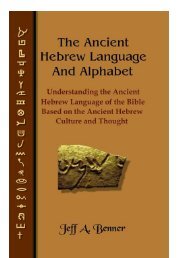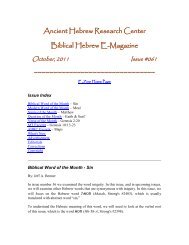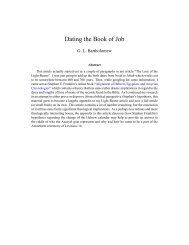My Name Forever - Ancient Hebrew Research Center
My Name Forever - Ancient Hebrew Research Center
My Name Forever - Ancient Hebrew Research Center
Create successful ePaper yourself
Turn your PDF publications into a flip-book with our unique Google optimized e-Paper software.
<strong>My</strong> <strong>Name</strong> <strong>Forever</strong> 9<br />
nouns Adonai hb«st and Elohim oh v«kt, respectively, imposed upon the letters of a verb. Gesenius sums<br />
up the matter nicely.<br />
As it is thus evident that the word vuvh does not stand with its own vowels, but with<br />
those of another word, the inquiry arises, what then are its true and genuine vowels? 29<br />
Y’hó I vh, Yáhu Uvh and Y’hu Uvh<br />
28. Since the <strong>Name</strong> cannot be learned by looking within the Tetragram itself, we have to look<br />
elsewhere. The first step in ascertaining its true pronunciation is, I believe, observing how it is<br />
pronounced when it is part of men's proper names. It appears three ways:<br />
•<br />
•<br />
•<br />
Y’hó I vh is how the <strong>Name</strong> appears at the beginning and in the middle of a man's name. It<br />
has two syllables. The first letter, Yud h, is pronounced as the “y” in “yes.” The Sh’va ( )<br />
under the initial Yud h (h) indicates “the absence of a vowel.” 30 It is such a slight sound that<br />
one hears little more than the consonant with which it is associated. The first syllable is Y’-<br />
-h. The next letter, Hei v, is the first letter of the second syllable. Pronounced as the “h” in<br />
“hoe,” it is often treated as though it were a silent letter and disappears from both speech<br />
and the printed page. The horizontal line ( ) under the Hei v ( v) is the accent mark. The<br />
accent is on the second syllable due to the nature of the Sh’va under the first. The letter<br />
which follows the Hei v is Vav u, the third letter of the Tetragram. It is not a consonant<br />
here, but a vowel, as there is a Holam ( « ) above it. The Vav/Holam combination (I) is<br />
pronounced “oh” like the “o” in “no.” The second syllable is -hó I v-. The Sh’va under the<br />
Yud h, followed by the often silent Hei v, helps us understand why Y’hó I vh is often found<br />
in a man’s name shortened to Yó Ih.<br />
Yáhu Uvh is how the <strong>Name</strong> appears at the end of a man's name. The accent was assigned to<br />
the first syllable. The Kamatz ( ) under the initial Yud h (h) is pronounced “ah” like the “a”<br />
in “father.” The first syllable is Yá -h. Instead of the Vav/Holam combination (I) after the<br />
Hei v of the second syllable there is a Shuruk (U) which is pronounced “oo” like the “u” in<br />
“flute.” The second syllable is -hu Uv-. Yáhu is often found shortened to Yáh vh.<br />
Y’hu Uvh is how the <strong>Name</strong> sometimes appears at the end of one particular name. The<br />
characteristics and pronunciation of the Yud h and the Sh’va of the first syllable is the same<br />
as in Y’hó I vh. The pronunciation of the Hei v and the Shuruk (U) of the second syllable is<br />
the same as in Yáhu Uvh. Although the second syllable should take the accent due to the<br />
nature of the Sh’va under the initial Yud h, the scribes saw fit to exclude it.<br />
29 Gesenius: Lexicon, p. 337.<br />
30 Menahem Mansoor: Biblical <strong>Hebrew</strong> Step By Step (Baker Book House, 1992), p. 33.






